NCERT Solutions for Class 9 Science Chapter 10 Gravitation
NCERT Solutions for Class 9 Science (physics) Chapter 10 Gravitation are given below. In these solutions, we have answered all the intext and exercise questions provided in NCERT class 9 science textbook. Class 9 NCERT Solutions Science Chapter 10 provided in this article are strictly based on the CBSE syllabus and curriculum. Students can easily download these solutions in PDF format for free from our app.
Class 9 Science Chapter 10 Textbook Questions and Answers
INTEXT QUESTION
PAGE NO 134
Question 1: State the universal law of gravitation
Answer: The universal law of gravitation states that every object in the universe attracts every other object with a force called the gravitational force. The force acting between two objects is directly proportional to the product of their masses and inversely proportional to the square of the distance between their centers.
For two objects of masses m1 and m2 and the distance between them r, the force (F) of attraction acting between them is given by the universal law of gravitation as:

Question 2: Write the formula to find the magnitude of the gravitational force between the earth and an object on the surface of the earth.
Answer: Let ME be the mass of the Earth and ‘m’ be the mass of an object on its surface. If R is the radius of the Earth, then according to the universal law of gravitation, the gravitational force (F) acting between the Earth and the object is given by the relation:

PAGE NO 136
Question 1: What do you mean by free fall?
Answer: Earth’s gravity attracts each object to its center. When an object is dropped from a certain height, under the influence of gravitational force it begins to fall to the surface of Earth. Such an object movement is called free fall.
Question 2: What do you mean by acceleration due to gravity?
Answer: When an object falls towards the ground from a height, then its velocity changes during the fall. This changing velocity produces acceleration in the object. This acceleration is known as acceleration due to gravity (g). Its value is given by 9.8 m/s2.
PAGE NO 138
Question 1: What are the differences between the mass of an object and its weight?
Answer:
| Mass | Weight |
| Mass is the quantity of matter contained in the body. | Weight is the force of gravity acting on the body. |
| It is the measure of inertia of the body. | It is the measure of gravity. |
| Mass is a constant quantity. | Weight is not a constant quantity. It is different at different places. |
| It only has magnitude. | It has magnitude as well as direction. |
| Its SI unit is kilogram (kg). | Its SI unit is the same as the SI unit of force, i.e., Newton (N). |
Question 2: Why is the weight of an object on the moon 1/6th its weight on the earth?
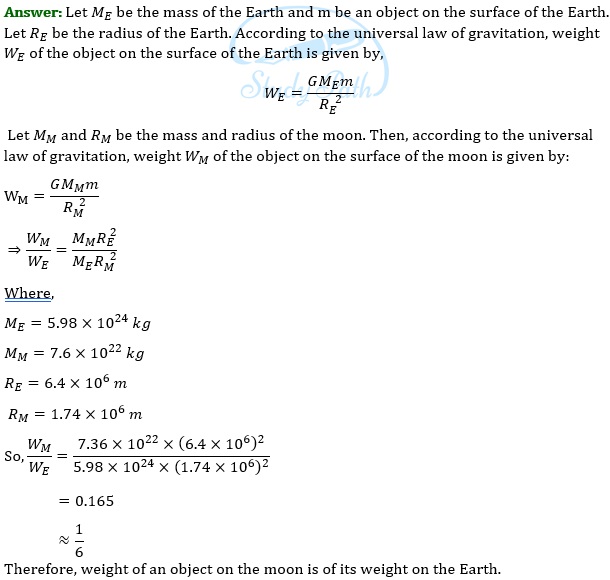
PAGE NO 141
Question 1: Why is it difficult to hold a school bag having a strap made of a thin and strong string?
Answer: It is difficult to hold a school bag having a thin strap because the pressure on the shoulders is quite large. This is because the pressure is inversely proportional to the surface area on which the force acts. The smaller is the surface area; the larger will be the pressure on the surface. In the case of a thin strap, the contact surface area is very small. Hence, the pressure exerted on the shoulder is very large.
Question 2: What do you mean by buoyancy?
Answer: The upward force exerted by a liquid on an object immersed in it is known as buoyancy. When you try to immerse an object in water, then you can feel an upward force exerted on the object, which increases as you push the object deeper into water.
Question 3: Why does an object float or sink when placed on the surface of water?
Answer: An object float or sink when placed on the surface of water because of two reasons.
(i) If its density is greater than that of water, an object sinks in water.
(ii) If its density is less than that of water, an object floats in water.
PAGE NO 142
Question 1: You find your mass to be 42 kg on a weighing machine. Is your mass more or less than 42 kg?
Answer: When you weigh your body, an upward force acts on it. This upward force is the buoyant force. As a result, the body gets pushed slightly upwards, causing the weighing machine to show a reading less than the actual value.
Question 2: You have a bag of cotton and an iron bar, each indicating a mass of 100 kg when measured on a weighing machine. In reality, one is heavier than other. Can you say which one is heavier and why?
Answer: The bag of cotton is heavier than iron bar. This is because the surface area of the cotton bag is larger than the iron bar. Hence, more buoyant force acts on the bag than that on an iron bar. This makes the cotton bag lighter than its actual value. For this reason, the iron bar and the bag of cotton show the same mass on the weighing machine, but actually the mass of the cotton bag is more than that of the iron bar.
EXERCISES
Question 1: How does the force of gravitation between two objects change when the distance between them is reduced to half?

Hence, if the distance is reduced to half, then the gravitational force becomes four times larger than the previous value.
Question 2: Gravitational force acts on all objects in proportion to their masses. Why then, a heavy object does not fall faster than a light object?
Answer: All objects fall on ground with constant acceleration, called acceleration due to gravity (in the absence of air resistances). It is constant and does not depend upon the mass of an object. Hence, heavy objects do not fall faster than light objects.
Question 3: What is the magnitude of the gravitational force between the earth and a 1 kg object on its surface? (Mass of the earth is 6 × 1024 kg and radius of the earth is 6.4 × 106 m).
Answer: Given,
Mass of Earth, M = 6 × 1024 kg
Mass of object, m = 1 kg
Universal gravitational constant, G = 6.7 × 10−11 Nm2 kg−2
Radius of the Earth, R = 6.4 × 106 m
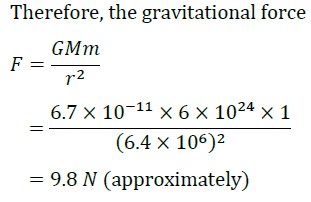
Question 4: The earth and the moon are attracted to each other by gravitational force. Does the earth attract the moon with a force that is greater or smaller or the same as the force with which the moon attracts the earth? Why?
Answer: According to the universal law of gravitation, two objects attract each other with equal force, but in opposite directions. The Earth attracts the moon with an equal force with which the moon attracts the earth.
Question 5: If the moon attracts the earth, why does the earth not move towards the moon?
Answer: The Earth and the moon experience equal gravitational forces from each other. However, the mass of the Earth is much larger than the mass of the moon. Hence, it accelerates at a rate lesser than the acceleration rate of the moon towards the Earth. For this reason, the Earth does not move towards the moon.
Question 6: What happens to the force between two objects, if
(i) the mass of one object is doubled?
(ii) the distance between the objects is doubled and tripled?
(iii) the masses of both objects are doubled?
Answer: According to the universal law of gravitation, the force of gravitation between two objects is given by:
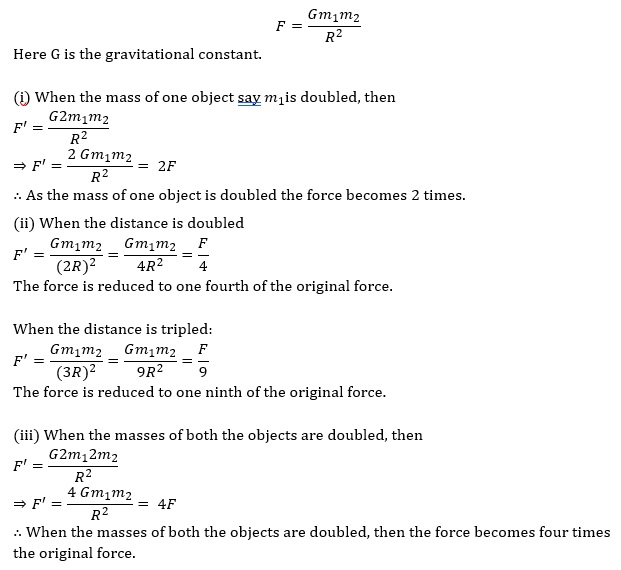
Question 7: What is the importance of universal law of gravitation?
Answer: The universal law of gravitation explains many phenomena that were believed to be unconnected:
(i) The motion of the moon round the earth
(ii) The force that binds North American nation to the world
(iii) The tides because of the moon and therefore the Sun
(iv) The motion of planets round the Sun
Question 8: What is the acceleration of free fall?
Answer: When objects fall towards the Earth under the effect of gravitational force alone, then they are said to be in free fall. Acceleration of free fall is 9.8 ms−2, which is constant for all objects (irrespective of their masses).
Question 9: What do we call the gravitational force between the Earth and an object?
Answer: Gravitational force between the earth and an object is known as the weight of the object.
Question 10: Amit buys few grams of gold at the poles as per the instruction of one of his friends. He hands over the same when he meets him at the equator. Will the friend agree with the weight of gold bought? If not, why? [Hint: The value of is greater at the poles than at the equator].
Answer: Weight of a body on the Earth is given by
W = mg
Where,
m = Mass of the body
g = Acceleration due to gravity
The value of g is greater at poles than at the equator. Therefore, gold at the equator weighs less than at the poles. Hence, Amit’s friend will not agree with the weight of the gold bought.
Question 11: Why will a sheet of paper fall slower than one that is crumpled into a ball?
Answer: Surface area of a Sheet which is crumpled into a ball, is much smaller than the surface area of a plain or flat sheet. Therefore, despite both experience same force of gravity, the plain or flat sheet of paper will have to face more air resistance than the crumpled ball, so it will fall slower than the sheet crumpled into a ball.
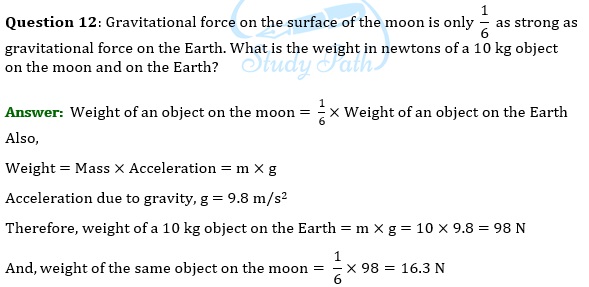
Question 13: A ball is thrown vertically upwards with a velocity of 49 m/s. Calculate:
(i) the maximum height to which it rises.
(ii) the total time it takes to return to the surface of the earth.
Answer: (i) According to the equation of motion under gravity v2 − u2 = 2gs
Where,
u = Initial velocity of the ball
v = Final velocity of the ball
s = Height achieved by the ball
g = Acceleration due to gravity
At maximum height, final velocity of the ball is zero, i.e., v = 0 m/s and u = 49 m/s
During upward motion, g = − 9.8 m s−2
Max. Height attained by the ball (s) = ?
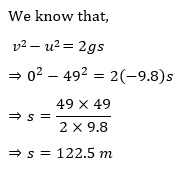
∴ Max. Height attained by the ball (s) = 122.5 m
(ii) Let t be the time taken by the ball to reach the height 122.5 m,
then according to the first equation of motion
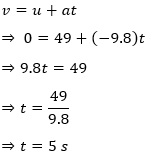
Time for upward journey of the ball will be the same as time for downward journey i.e., t = 5 s.
Therefore, total time taken by the ball to return = 5 + 5 = 10 s
Question 14: A stone is released from the top of a tower of height 19.6 m. Calculate its final velocity just before touching the ground.
Answer: According to the equation of motion under gravity v2 − u2 = 2gs
Where,
u = Initial velocity of the stone = 0 m/s
v = Final velocity of the stone
s = Height of the stone = 19.6 m
g = Acceleration due to gravity = 9.8 ms−2
Now, v2 = u2 + 2as
⇒ v2 − u2 = 2as
⇒ v2 − 02 = 2 × 9.8 × 19.6
⇒ v2 = 2 × 9.8 × 19.6
⇒ v2 = 19.6 × 19.6
⇒ v2 = (19.6)2
⇒ v = 19.6 ms−1
Hence, the velocity of the stone just before touching the ground is 19.6 ms−1.
Question 15: A stone is thrown vertically upward with an initial velocity of 40 m/s. Taking g = 10 m/s2, find the maximum height reached by the stone. What is the net displacement and the total distance covered by the stone?
Answer: Given
u = Initial velocity of the stone = 40 m/s
v = Final velocity of the stone = 0 m/s
s = Height of the stone
g = Acceleration due to gravity = −10 ms−2
the maximum height attained by the stone (s) = ?
According to the equation of motion under gravity,
v2 − u2 = 2gs
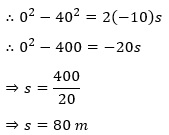
Therefore, total distance covered by the stone during its upward and downward journey = 80 + 80 = 160 m
Net displacement during its upward and downward journey = 80 + (−80) = 0.
Question 16: Calculate the force of gravitation between the earth and the Sun, given that the mass of the earth = 6 × 1024 kg and of the Sun = 2 × 1030 kg. The average distance between the two is 1.5 × 1011 m.
Answer:
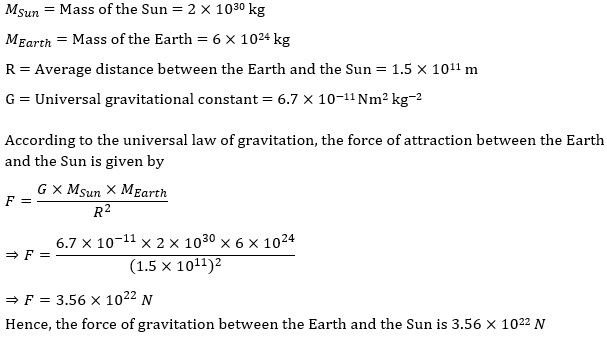
Question 17: A stone is allowed to fall from the top of a tower 100 m high and at the same time another stone is projected vertically upwards from the ground with a velocity of 25 m/s. Calculate when and where the two stones will meet.
Answer: Let the two stones meet after a time t.
When the stone dropped from the tower
Initial velocity, u = 0 m/s
Let the displacement of the stone in time t from the top of the tower be s.
Acceleration due to gravity, g = 9.8 ms−2
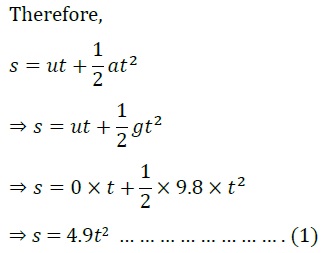
When the stone thrown upwards
Initial velocity, u = 25 ms−1
Let the displacement of the stone from the ground in time t be 𝑠′.
Acceleration due to gravity, g = −9.8 ms−2
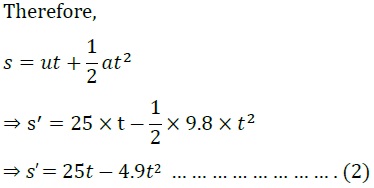
The combined displacement of both the stones at the meeting point is equal to the height of the tower 100 m.
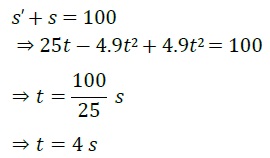
In 4 s, the falling stone has covered a distance given by (1) as 𝑠 = 4.9 × 42 = 78.4 𝑚
Therefore, the stones will meet after 4s at a height (100 – 78.4) = 20.6 m from the ground.
Question 18: A ball thrown up vertically returns to the thrower after 6 s. Find
(a) The velocity with which it was thrown up,
(b) The maximum height it reaches, and
(c) Its position after 4s.
Answer: (a) The velocity with which ball was thrown up :
Acceleration due to gravity, g = – 9.8 ms–2
As the total time taken in upward and return journey by the ball is 6 s.
Therefore, The upward journey, t = 6/2 s = 3 s
Final velocity, v = 0 ms–1
Initial velocity, u = ?
Using equation of motion, v = u + at, we have
0 = u + (−9.8 × 3)
⇒ u = 9.8 × 3
⇒ u = 29.4 m/s
Hence, the ball was thrown upwards with a velocity of 29.4 m/s.
(b) Let the maximum height attained by the ball be s.
Initial velocity during the upward journey, u = 29.4 m/s
Final velocity, v = 0 m/s
Acceleration due to gravity, g = −9.8 ms−2
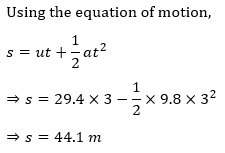
Hence, the maximum height is 44.1 m.
(c) Ball attains the maximum height after 3s. After attaining this height, it will start falling downwards.
In this case,
Initial velocity, u = 0 m/s
Position of the ball after 4 s of the throw is given by the distance travelled by it during its downward journey in 4 s − 3 s = 1 s.
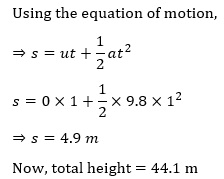
Now, total height = 44.1 m
This means, the ball is 39.2 m (44.1 m − 4.9 m) above the ground after 4 seconds.
Question 19: In what direction does the buoyant force on an object immersed in a liquid act?
Answer: An object immersed in a liquid experiences buoyant force in the upward direction.
Question 20: Why does a block of plastic released under water come up to the surface of water?
Answer: Two forces act on an object immersed in water. One is the gravitational force, which pulls the object downwards, and the other is the buoyant force, which pushes the object upwards. If the upward buoyant force is greater than the downward gravitational force, then the object comes up to the surface of the water as soon as it is released within water. Due to this reason, a block of plastic released under water comes up to the surface of the water.
Question 21: The volume of 50 g of a substance is 20 cm3. If the density of water is 1 g cm−3, will the substance float or sink?
Answer: If the density of an object is more than the density of a liquid, then it sinks in the liquid. On the other hand, if the density of an object is less than the density of a liquid, then it floats on the surface of the liquid.
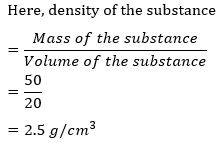
The density of the substance is more than the density of water (1 g cm−3). Hence, the substance will sink in water.
Question 22: The volume of a 500 g sealed packet is 350 cm3. Will the packet float or sink in water if the density of water is 1 g cm−3? What will be the mass of the water displaced by this packet?
Answer: Density of the 500 g sealed packet
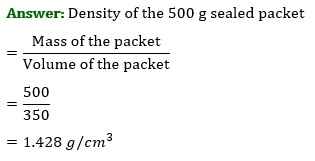
The density of the substance is more than the density of water (1𝑔/𝑐𝑚3). Hence, it will sink in water.
The mass of water displaced by the packet is equal to the volume of the packet, i.e., 350g.
Class 9 Science NCERT Solutions Chapter 10 Gravitation
CBSE Class 9 Science NCERT Solutions Chapter 10 helps students to clear their doubts and to score good marks in the board exam. All the questions are solved by experts with a detailed explanation that will help students complete their assignments & homework. Having a good grasp over CBSE NCERT Solutions for Class 9 Science will further help the students in their preparation for board exams and other competitive exams such as NTSE, Olympiad, etc.
NCERT Solutions for Class 9 Science Chapter 10 PDF
Below we have listed the topics discussed in NCERT Solutions for Class 9 Science Chapter 10. The list gives you a quick look at the different topics and subtopics of this chapter.
| Section in NCERT Book | Topics Discussed |
|---|---|
| 10.1 | Gravitation |
| 10.1.1 | Universal Law of Gravitation |
| 10.2 | Free Fall |
| 10.3 | Mass |
| 10.4 | Weight |
| 10.5 | Thrust and Pressure |
| 10.5.2 | Buoyancy |
| 10.6 | Archimedes’ Principle |
| 10.7 | Relative Density |